Summer 2025 News
Summer 2025 Newsletter
Kindness & Gratitude Matter
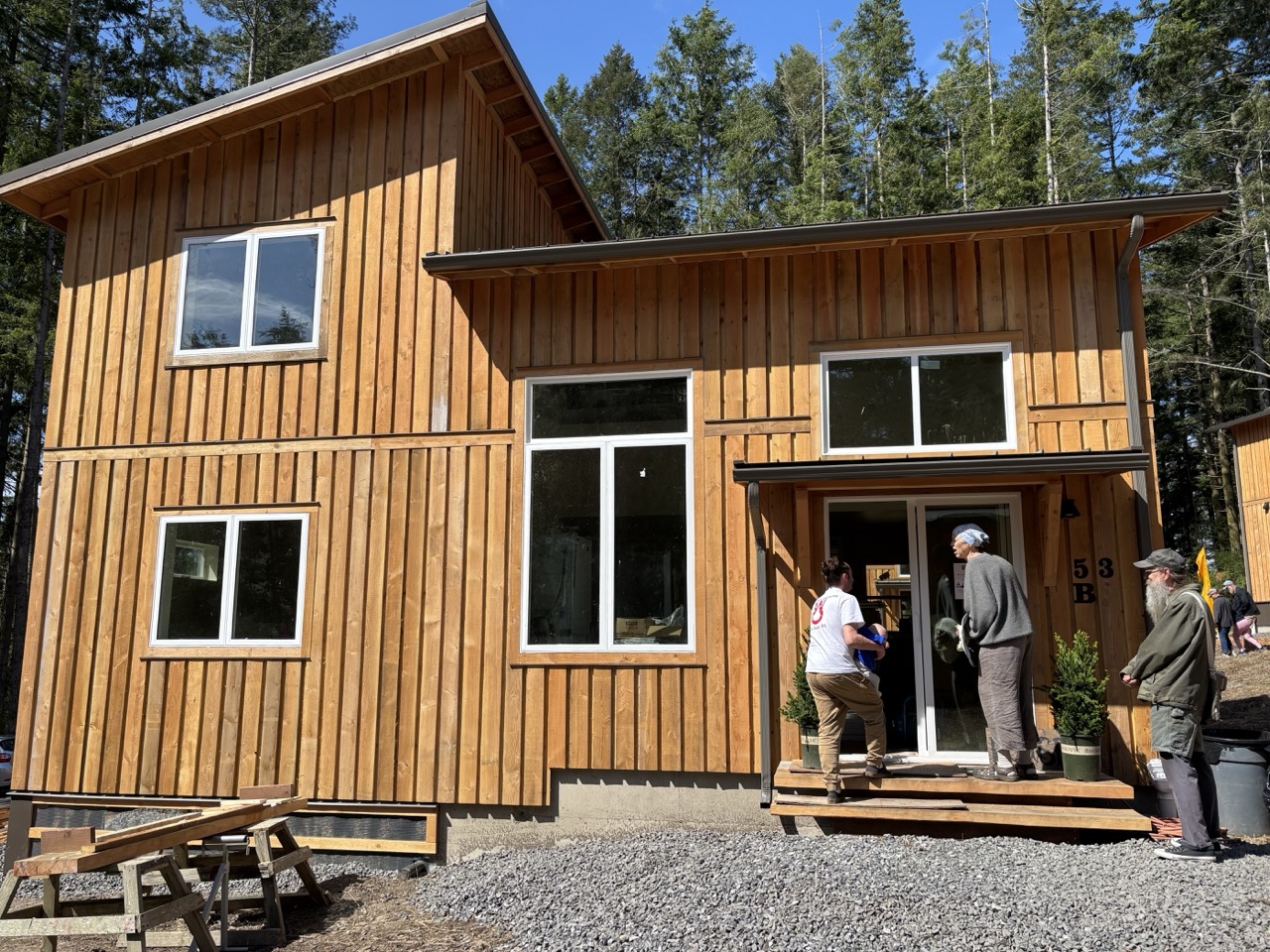 Justin Hurley, with a twin baby in hand, gladly showed their new home on Crayfish Way
Justin Hurley, with a twin baby in hand, gladly showed their new home on Crayfish Way
at the Open House to Ona Blue and Neil Hanson of the Morgantown Co-op.
Director’s Report
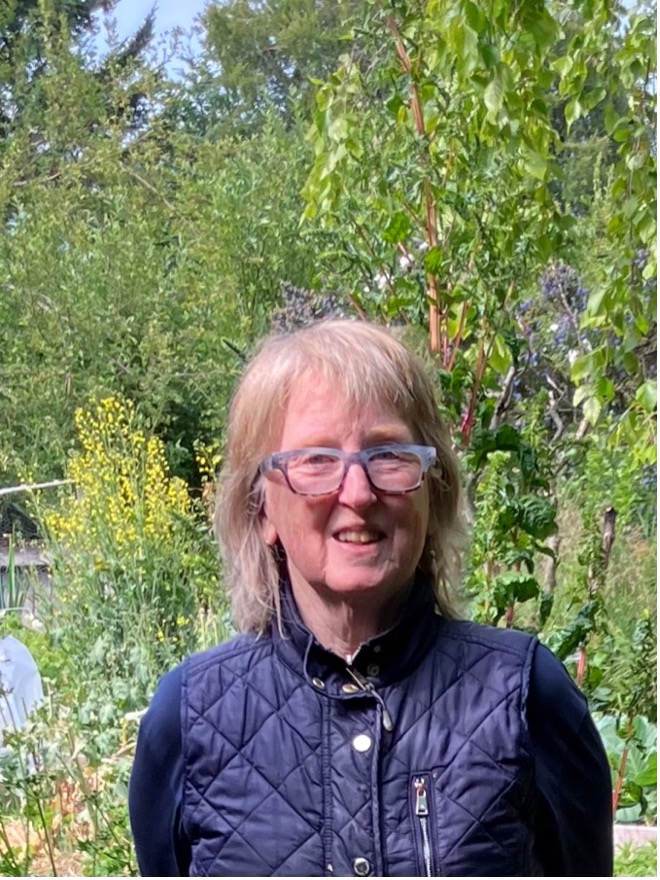 By LCLT Executive Director Sandy Bishop
By LCLT Executive Director Sandy Bishop
Sustaining a resilient community takes effort. The quality of community life on Lopez can’t be bought and paid for. It is the result of a lot of people giving generous amounts of volunteer time to make us that “idyllic” community we are renowned for. Lopez would not be what it is without all the work people gladly do to create our sense of community. For this and more, LCLT is deeply grateful. I read The Serviceberry recently and like this quote:
“I want to live in a society where the currency of exchange is gratitude and the infinitely renewable resource of kindness, which multiplies every time it is shared, rather than depreciating with use.” — Robin Wall Kimmerer, The Serviceberry: Abundance and Reciprocity in the Natural World
We want to thank all those who gift us in so many ways—through volunteering, donating, providing lunches, LCLT residents passing it forward, and more. Each of the new homeowners moving into the Oystercatcher neighborhood on Crayfish Way have much to be grateful for, but it means so much more knowing that the same people we meet in the grocery store, or at concerts, or in the ferry line, or serving us at a local establishment, or donating, are all in relationship with each other. When life is more than a transaction—when living on an island is more about making relationships than simply extracting an experience, we have created community.
Open House at Crayfish Way
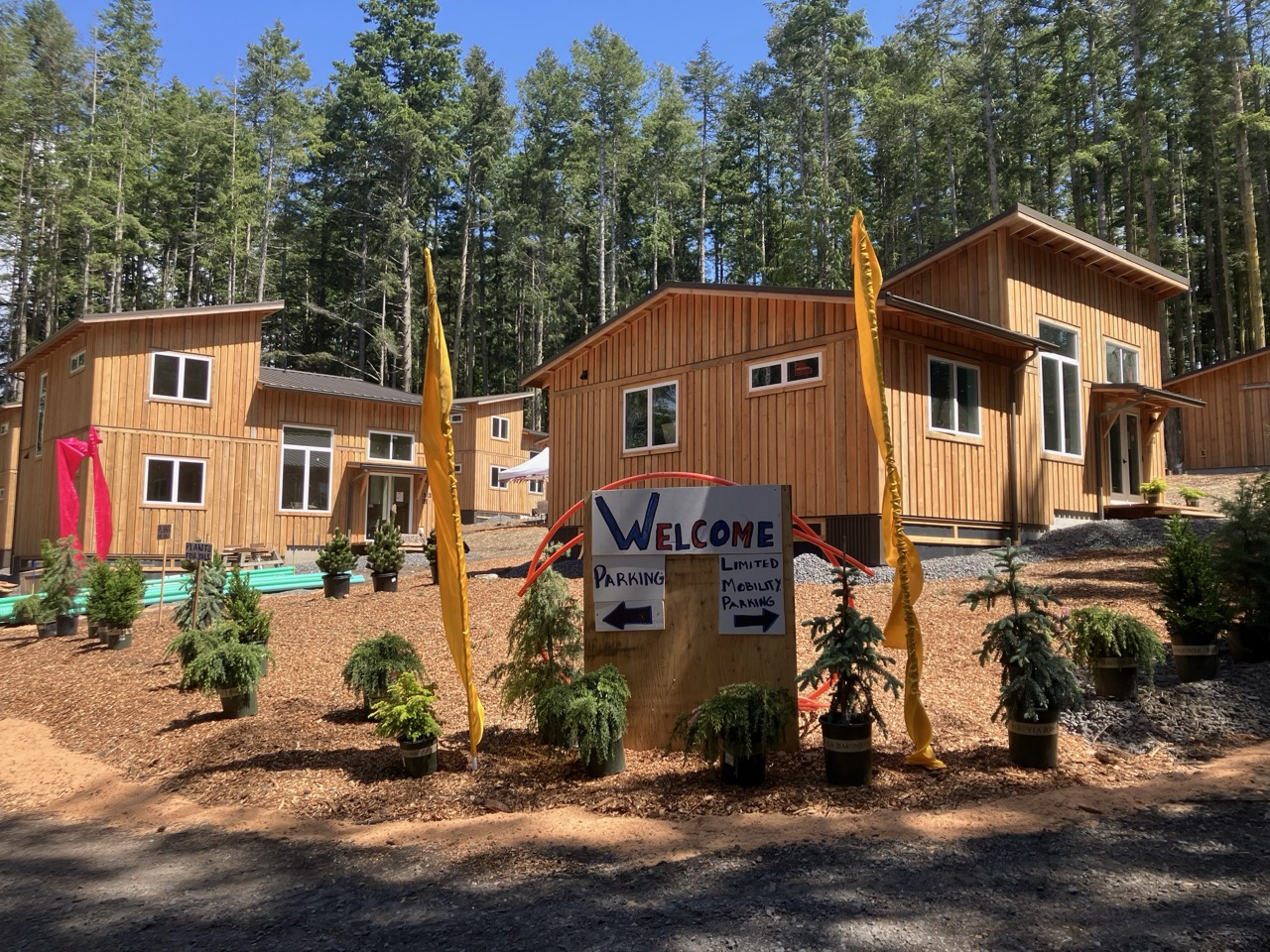
On May 18, we opened the doors to the Lopez Community to tour through the not-quite-finished homes at Crayfish Way. Over 250 people came out to celebrate and see the results of a year of hard work!
Funding for this project is sourced through the San Juan County Home Fund (46%), a mortgage through the Washington State Housing Finance Commission (34%), and generous support from community members (20%). In addition to hired labor, the residents, building partners, volunteers and LCLT construction interns contributed over 5000 hours to build these homes.
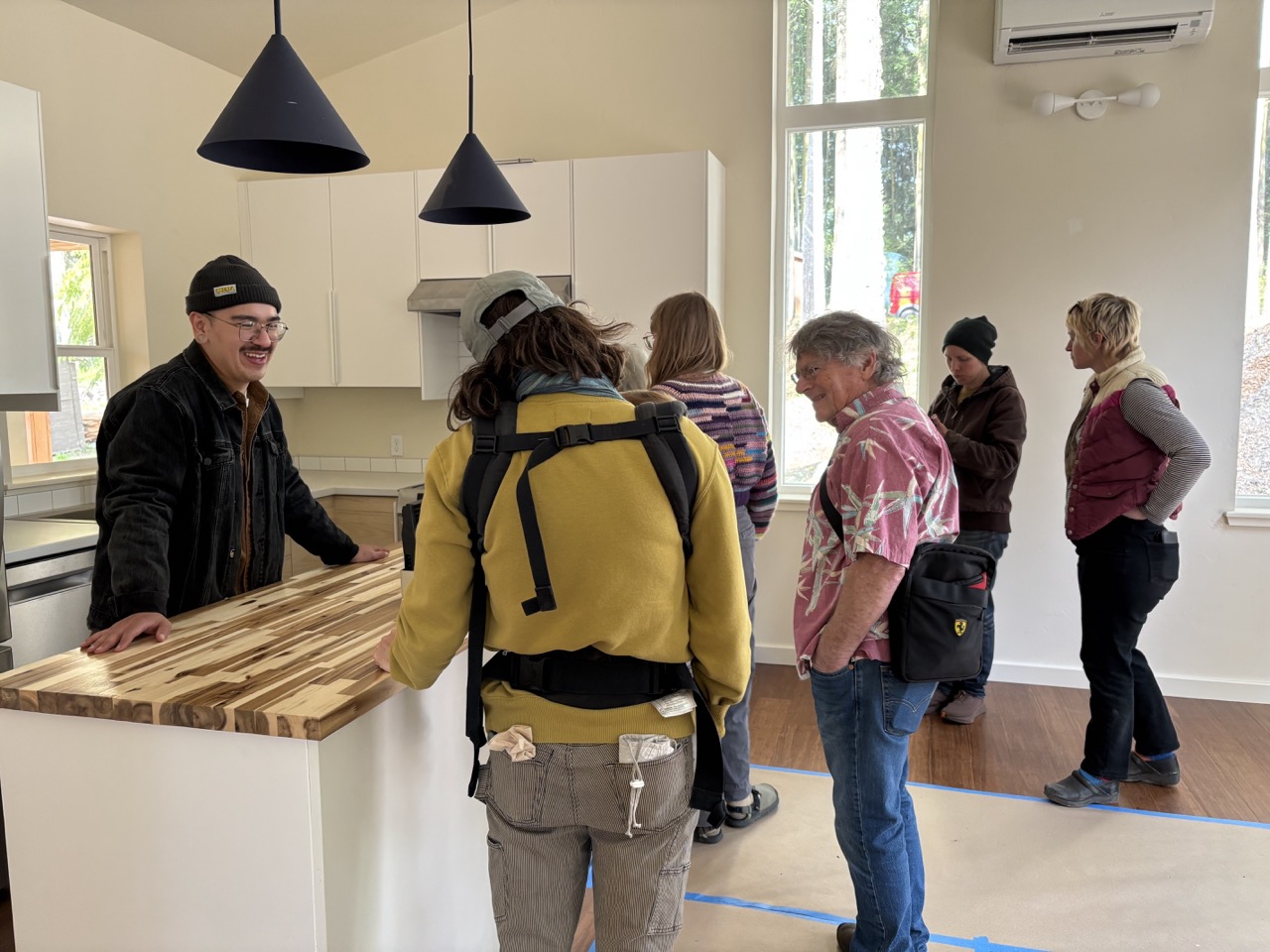 Visitors enjoy seeing the new home of Kenny (L) and Aubrey Mai, owners of Lopez Village Cycles.
Visitors enjoy seeing the new home of Kenny (L) and Aubrey Mai, owners of Lopez Village Cycles.
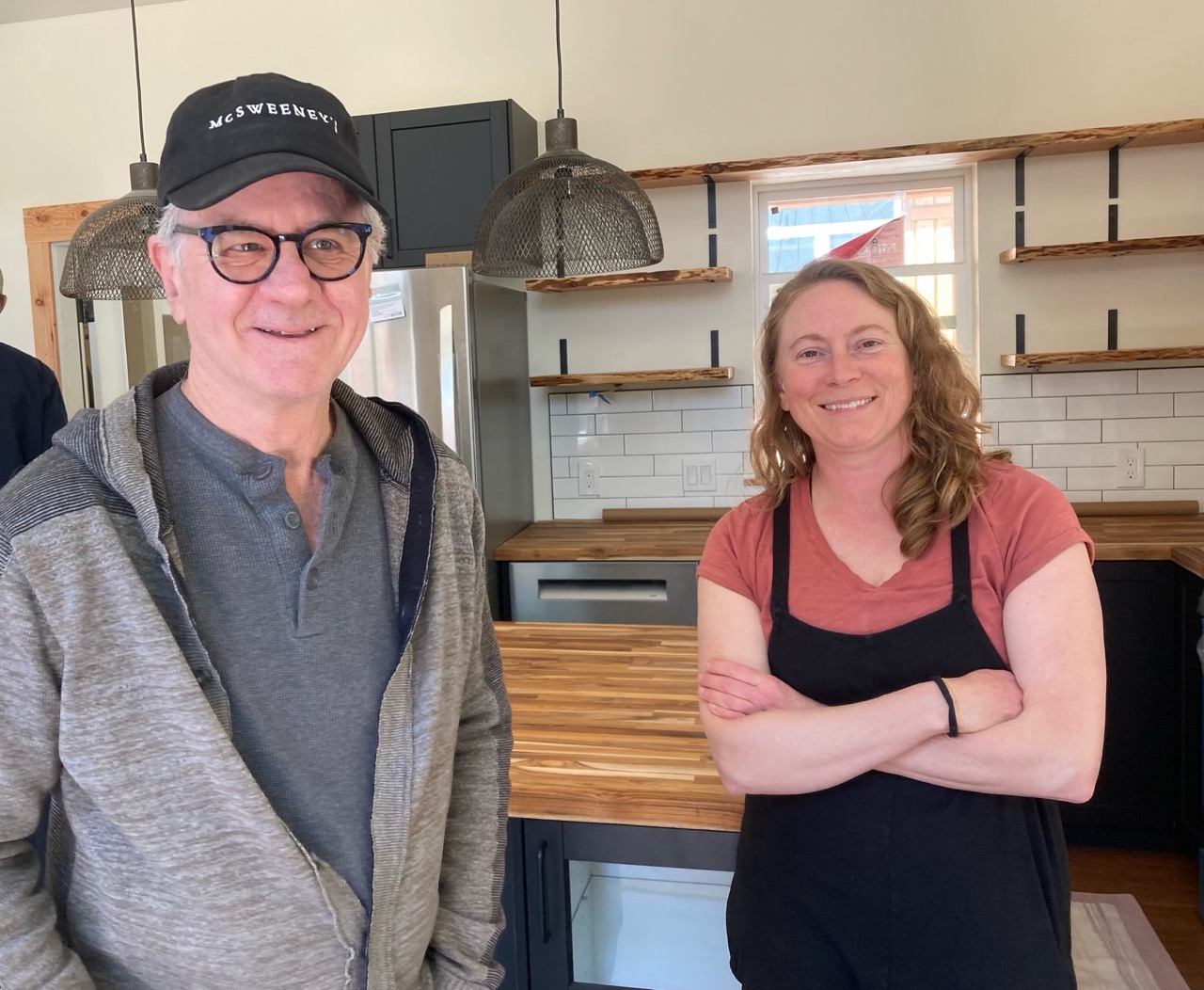 Amy Frost, Lopez Museum Director (R) welcomed Richard Marshall to her new home.
Amy Frost, Lopez Museum Director (R) welcomed Richard Marshall to her new home.
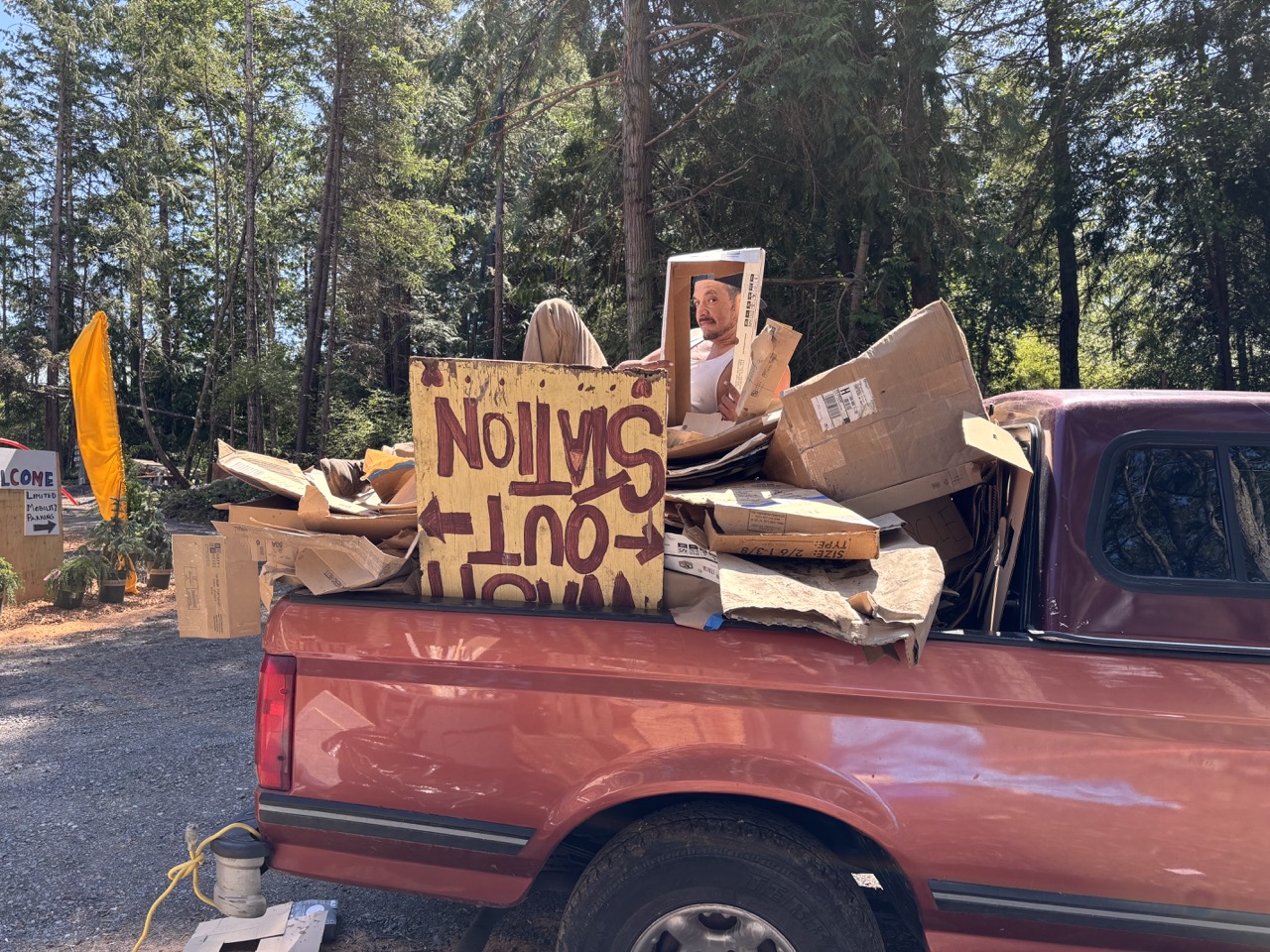 Juan Velasquez, neighbor from another co-op, provided over 100 hours of labor getting the site ready.
Juan Velasquez, neighbor from another co-op, provided over 100 hours of labor getting the site ready.
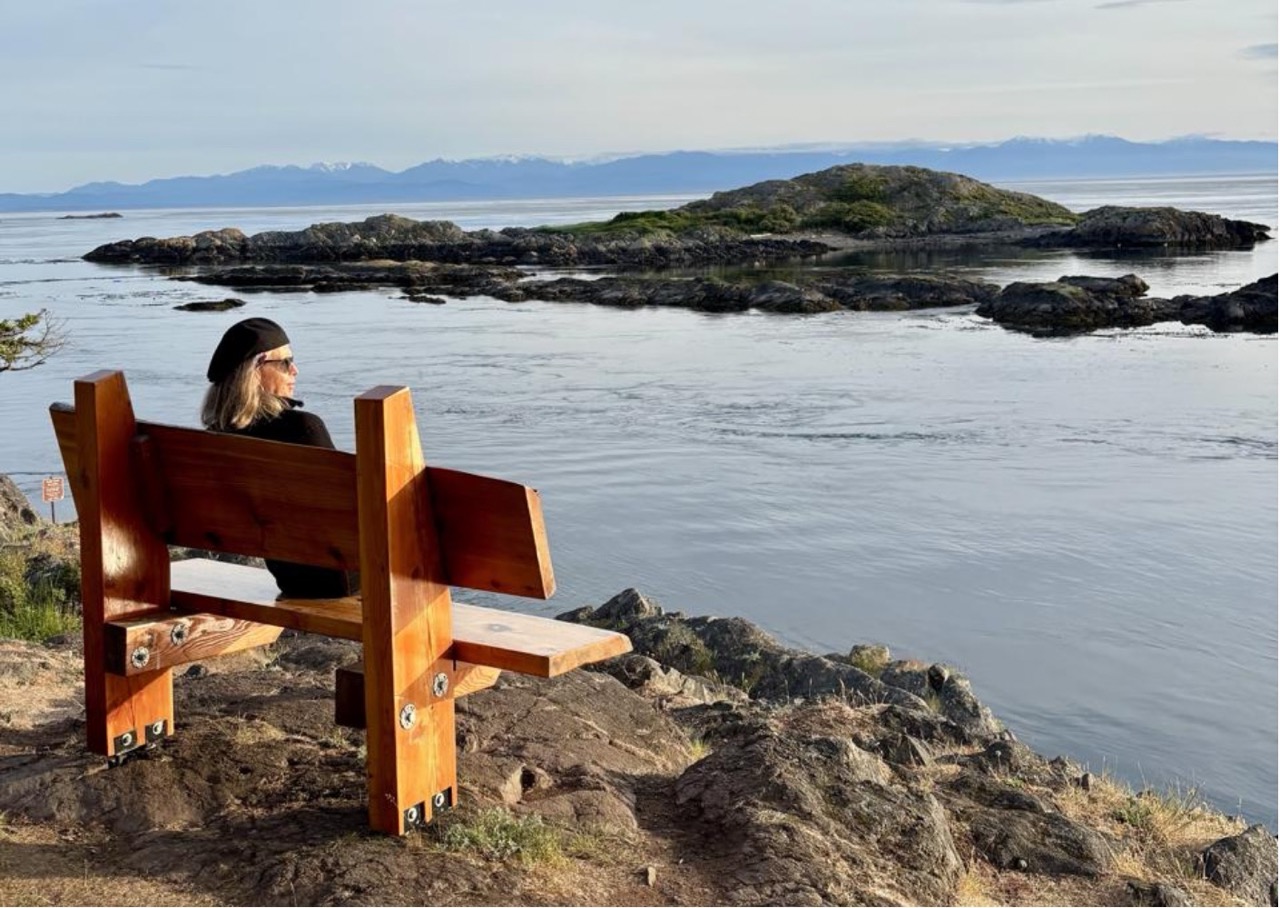 Cover photo (above) and article referenced by Leslie Kelly, contributor at Forbes, June 5, 2025:
Cover photo (above) and article referenced by Leslie Kelly, contributor at Forbes, June 5, 2025:
This Island Getaway Is So Idyllic, Some Would Prefer To Keep It Secret.
Lopez — an Unaffordable “Idyllic Getaway”
By Breton Carter, LCLT Assistant Director
You may have recently seen the new Forbes article that squarely put Lopez on the national map, again. LCLT incorporated in 1989 when the cost of housing rose 190% in a single year – just after the Wall Street Journal published an article featuring the San Juan Islands. Not to say a single article holds that much influence, but a new national headline seems to appear every few years, and has some unintended consequences. What each article fails to mention is the challenge of living on a small island with few affordable housing options.
In San Juan County (SJC), the median home price is $956,000 – the second most expensive county in the state of Washington, with King County (home of Seattle) as number one. Meanwhile, the average annual wage in SJC is among the lowest in the state at just $51,918, a number that hasn’t changed much since at least 2017. A homebuyer would have to earn four times the median wage to afford a home here. In the islands, there isn’t a shortage of homes; there are approximately two homes for every full-time resident, but on Lopez, 50% remain unoccupied full time. In comparison, 28% of the houses on San Juan are occupied part time, and 39% on Orcas. The statewide average shows only 7.4% of homes are occupied part time.
The Forbes article does a nice job highlighting local foods and producers but fails to acknowledge the tremendous community effort it takes for these “highlights” to exist. Individuals and organizations, including LCLT, work collaboratively to bring more resilience to the local economy. Since 2001, LCLT has published the Farm Products Guide to feature local ag producers. We also partner with local farms through an internship program. We have purchased and hold in trust over 108 acres of ag-related land on Lopez Island. LCLT continues to develop housing which is home to many in ag-related businesses. Stability from affordable housing holds the community together. Carpenters, paramedics, musicians, community organizers, landscapers, grocery store clerks, childcare workers, teachers, and farmers are part of what makes this a special place. Our island depends on people rooted in and committed to the community. It takes work and long-term relationships to make it all happen.
The Forest House
We are planning to complete the Forest House, located on Lopez Sound Road, in the third quarter of this year. It will then be offered for sale for $340,000, house-only, with a 99-year lease on the land. The home is being offered to a household working in the local food system. More information will be posted when the home is nearer completion.
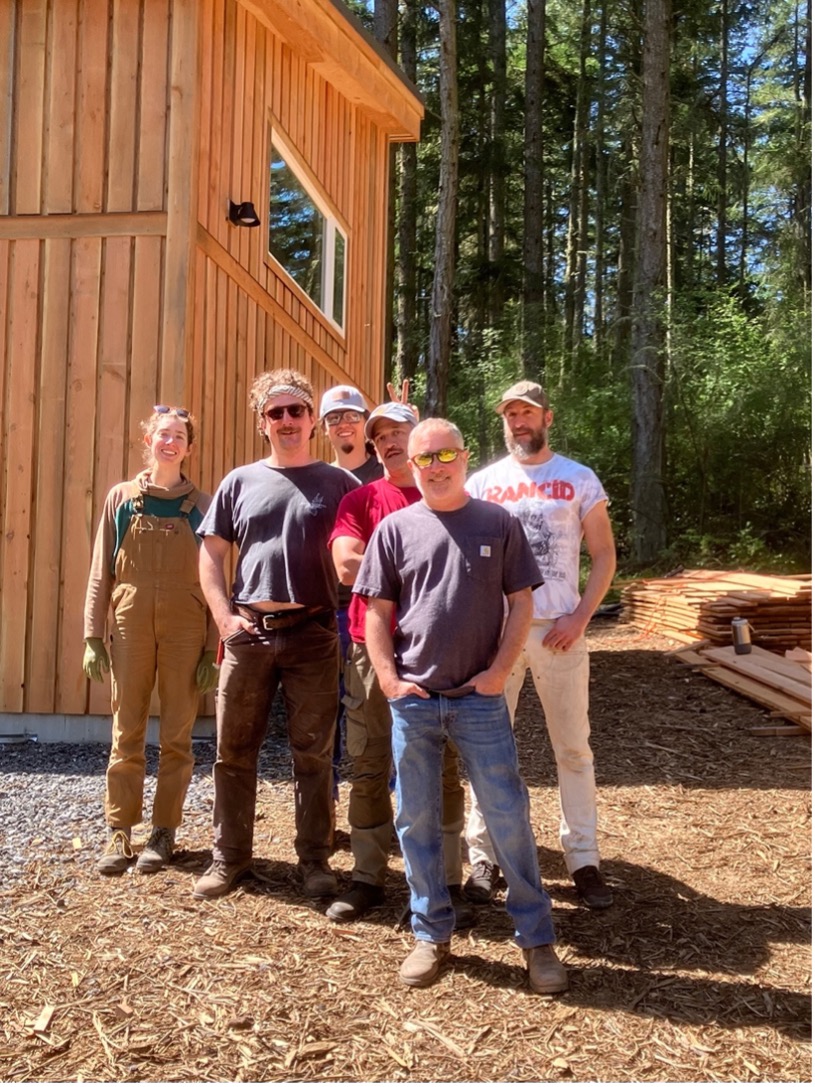
Some of the Forest House building crew: Rachel Zable, David Hellman,
Blaze Guo, Alex Forster, David Lawrence and Dane Atkins.
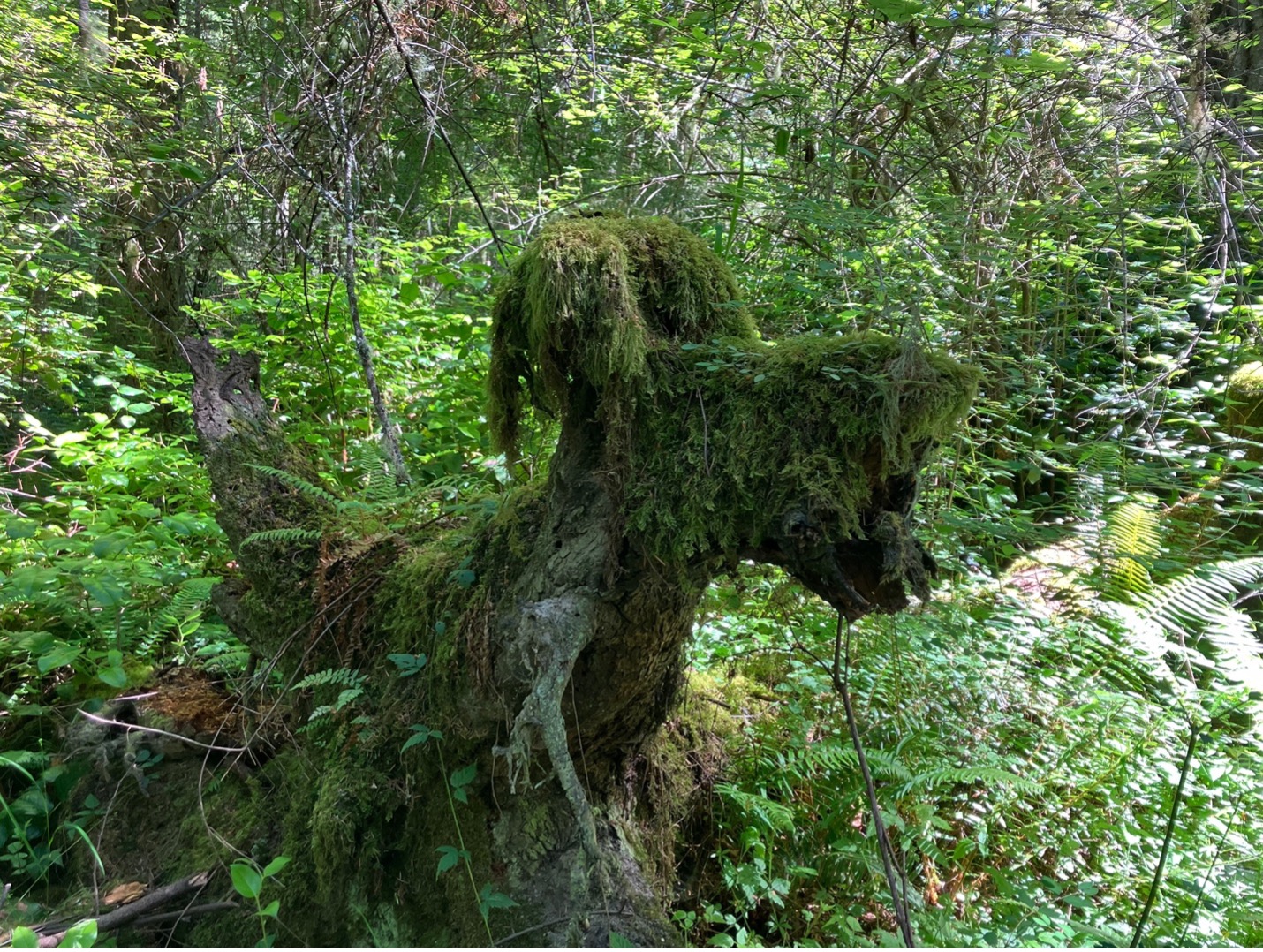
A nearby woodland creature awaits news of the new Forest House owner.
Portobello Rental
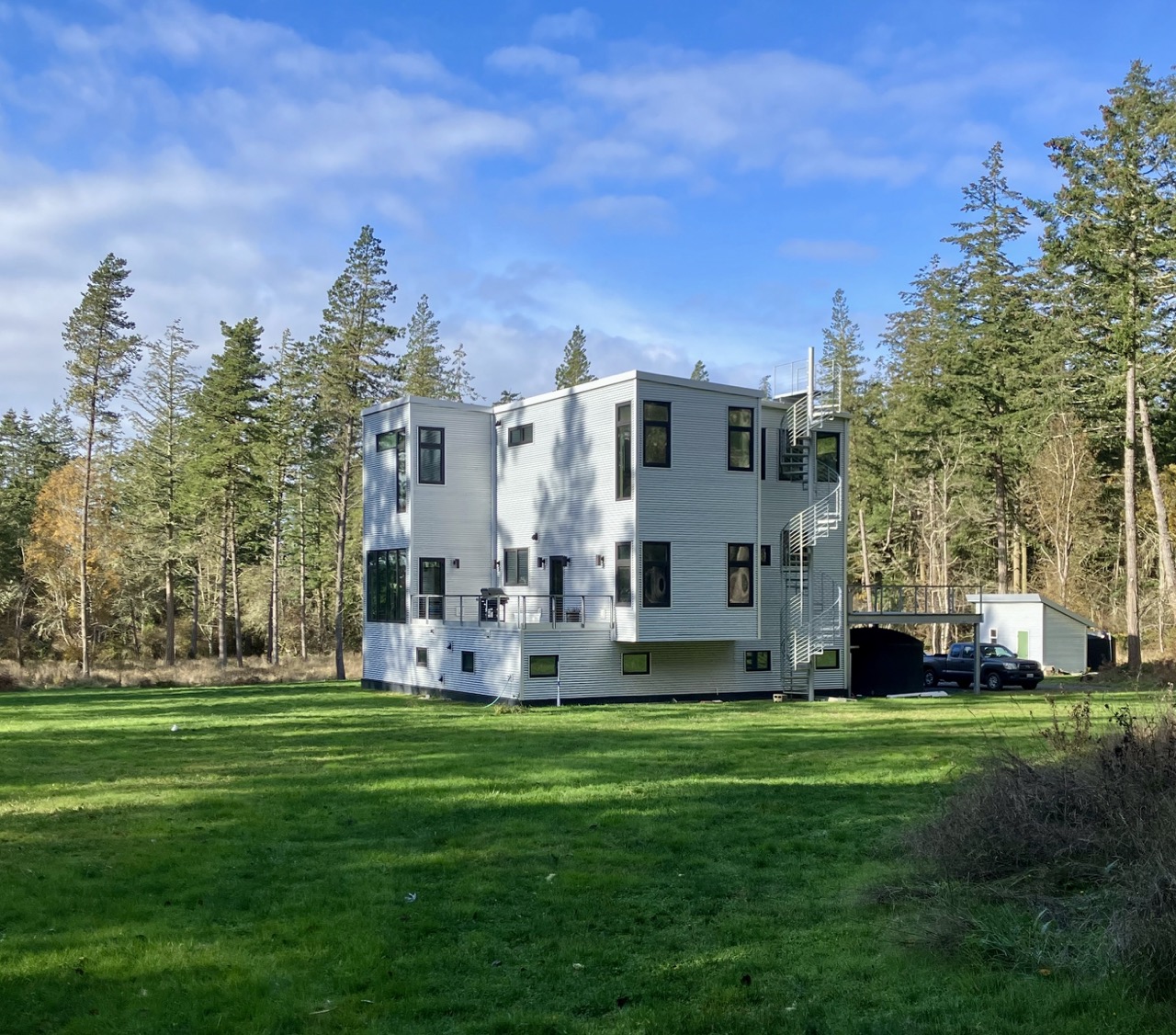
At the LCLT Annual Meeting in March, we had the pleasure of announcing that a generous local donor gifted a house to LCLT on Portobello Road. We are deeply grateful to add this home to LCLT’s rental options on Lopez. LCLT is hoping to offer the home to a new physician and is awaiting an update on the status of the hire.
Unexpected Connections:
Two stories of LCLT bringing people together, locally and across the globe.
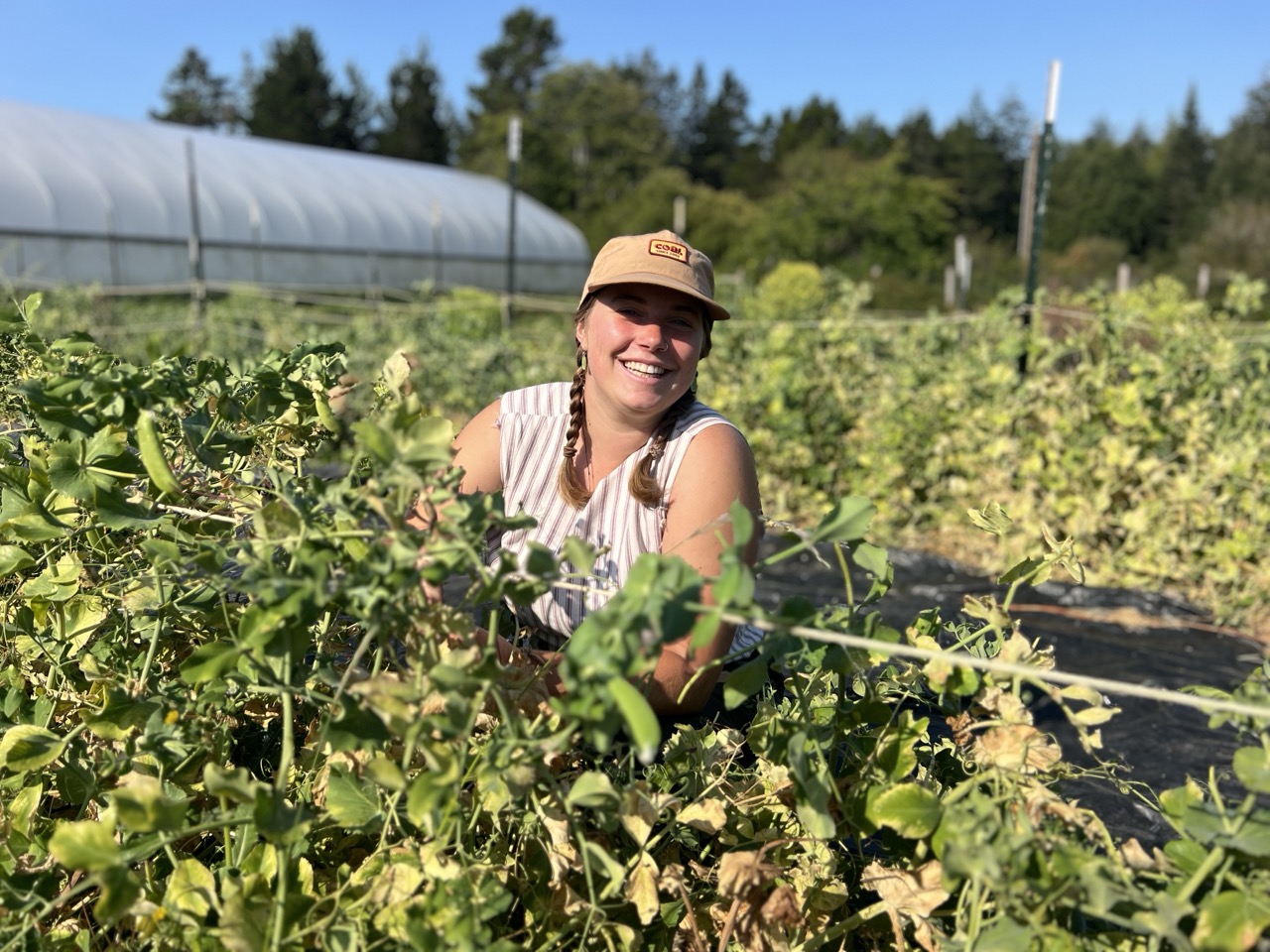
Emma Owens, 2024 SARD Intern pictured at Watmough Bay Farm.
The LCLT Tote Bag That Made the World Feel Less Daunting
By Emma Owens
Last summer, I had the pleasure of participating in the Sustainable Agriculture internship program through LCLT on Lopez Island. Upon my completion, we were sent off with some kind words, a certificate, good friends, and ‘most importantly’, a tote bag. That magically unassuming bag draws eyes, compliments, and little anecdotes about others’ experiences, or their times spent on Lopez. As a young person, the world can feel very large and daunting at times. But I am comforted and tethered by these sorts of interactions that make strangers feel a little more like neighbors.
After graduating from WWU last spring, I tried a few jobs in different parts of the Pacific Northwest before landing in Seattle at the beginning of this year. I have met many people since moving to this big city, most of them through friends I made in other places. The web of connections seems almost never ending at times.
So that I could continue to meet people, stay active, and out of my apartment during the winter, I got a trial membership at the local bouldering gym. One day, as I was checking in for a class at the front desk, the attendant complimented me on my bag and asked how I was connected to the island.
“I went to school with someone named Rachel who just moved to Lopez,” she said. “She worked for the Land Trust last summer.”
Being the small island and program that it is, Rachel and I were doing different jobs, but still made it a point to go to gatherings and explore the island. She had even lived with my incredible host, Peggy Bill, after I’d finished my internship.
But it doesn’t end there. As we chatted about the island, and each of our connections to it, another person approached, drawn by our conversation. “Are you talking about internships on Lopez Island?” she asked. When I confirmed that I’d done the sustainable agriculture program, she put a hand over her mouth. She was starting the exact same internship in just a few months! Curious, I asked about her placement, which farms, and host, certain I’d recognize some of the names. Turns out, she will be working at one of the same farms as me, and staying with the same host that I did! Peggy! After some gasps and giggles I made sure to give her my number in case she had any questions. We parted ways, and I smiled knowing that the connections that I made on Lopez in just 6 weeks continue to echo into my daily life even now. In this big city that often feels overwhelmingly anonymous, the tote bag reminds me that we are all part of something smaller, more intimate, and more interconnected than we often realize.
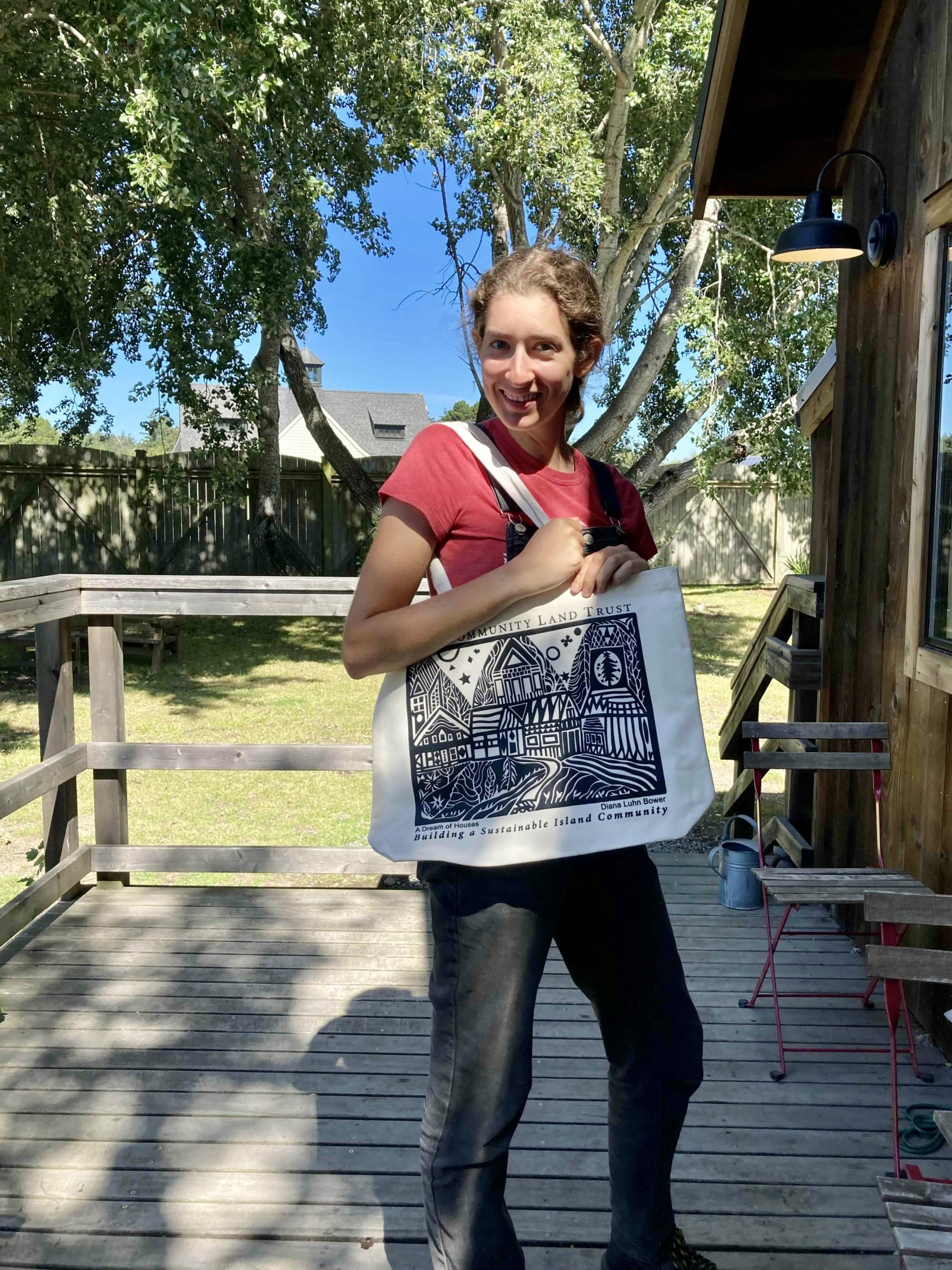
Rachel Zable with LCLT tote. Rachel was a 2024 Construction Intern and
in 2025, a hired carpenter for Crayfish Way.
LCLT tote bags are available for purchase exclusively at Chimera Art Gallery in the Lopez Plaza Building.
LCLT Connects – From Lopez to Bhutan

Finn and Eleanor meeting in Bhutan.
This April, LCLT board member Eleanor Brekke took a trip to Bhutan. To travel there, you’re required to book through a travel company and have a tour guide. Eleanor found a small family-owned business, whose website proclaimed they were “closed for travel in 2024 because of too many tourists,” but open in 2025. The thoughtfulness appealed to Eleanor, so she reached out. The first point of contact was a member of the family-owned business who lives in New York. When he learned Eleanor was from the Seattle area, he was excited. “Oh, you’re from Seattle? My brother who lives in Bhutan lived in Seattle for a while!” When she explained the classic, “well not really Seattle, but a small island north of there…” he followed up asking, “which island?” and when she said “Lopez” he exclaimed “that’s where I went with my brother!” The connection led to thoughtful travel plans with a homestay in the eastern part of Bhutan.
Fast forward to the trip itself. Eleanor got to meet Finn, the brother who lives in Bhutan, and used to live in Seattle. She of course had to ask about his time in Washington and the trip to Lopez Island. As it turns out, Finn was on Lopez for more than a short trip. “I was an intern for an organization called the Lopez Community Land Trust. Have you heard of it?”
Eleanor was amazed! She explained her longtime connection and current role as Treasurer of the board. Finn was an intern at LCLT in 2007 in the early stages of Common Ground, building forms, pouring concrete for foundations and putting together the metal water tank. Before the trip, LCLT Executive Director Sandy Bishop had told Eleanor, “We had an intern from Bhutan, maybe you’ll meet him. At the time, the King was telling young people to go out into the world, see what other people do, and bring the knowledge back.” Finn came to Seattle and Lopez, and then home to Bhutan. He said that “To this day, being an intern at LCLT was one of the most influential and meaningful things I’ve done. It was a really special experience. I hope I can bring my family to visit!”

Finn and his son.
Reflecting on the trip and chance experience of meeting Finn, Eleanor shared her amazement. “Here I was in Bhutan, meeting someone who had been to Lopez. We felt really connected, that throughout the world, we’ve sought the same things – community, nature, care of the environment, connection to the land and the feeling of being stewards of the land.”
Welcome 2025 LCLT SARD Interns!
This summer, LCLT is hosting 6 interns in Sustainable Agriculture and Rural Development. If you meet them on Lopez, be sure to give a warm welcome.
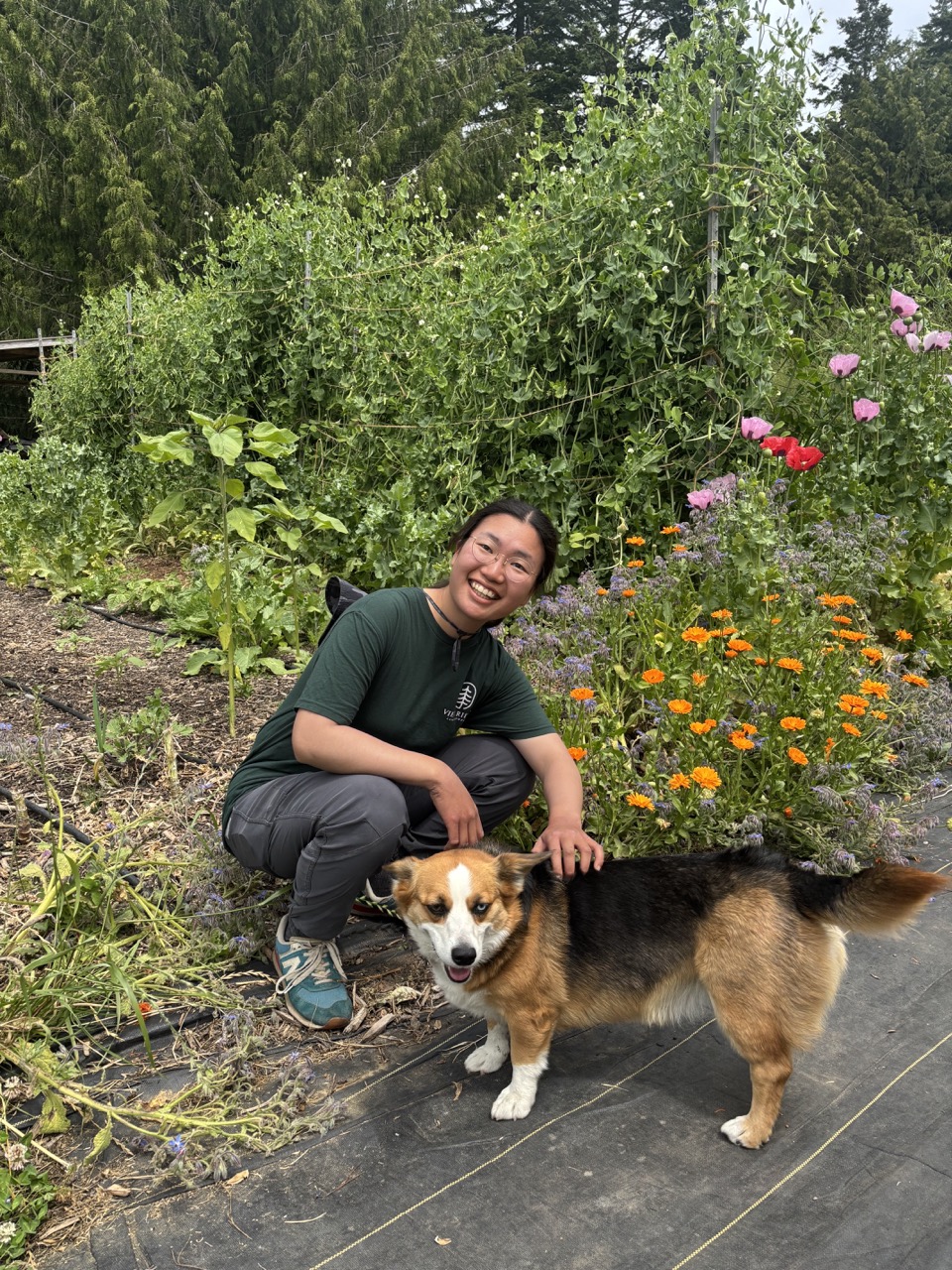
Kanami Suzuki with Cora the corgi at Midnight’s Farm.
Kanami was the first LCLT intern to arrive this Spring. She is splitting her time between Midnight’s Farm and the Lopez School Garden. Kanami is an international student from Japan who spent this past year at Rutger’s University studying Environmental Science, agriculture and food systems. Kanami has been learning how to rotate crops, use tools effectively to not strain her body, and is testing ratios of compost and biochar to made the ultimate potting soil with local resources. She also is writing news updates for the Lopez School Garden! You can find the first one here.
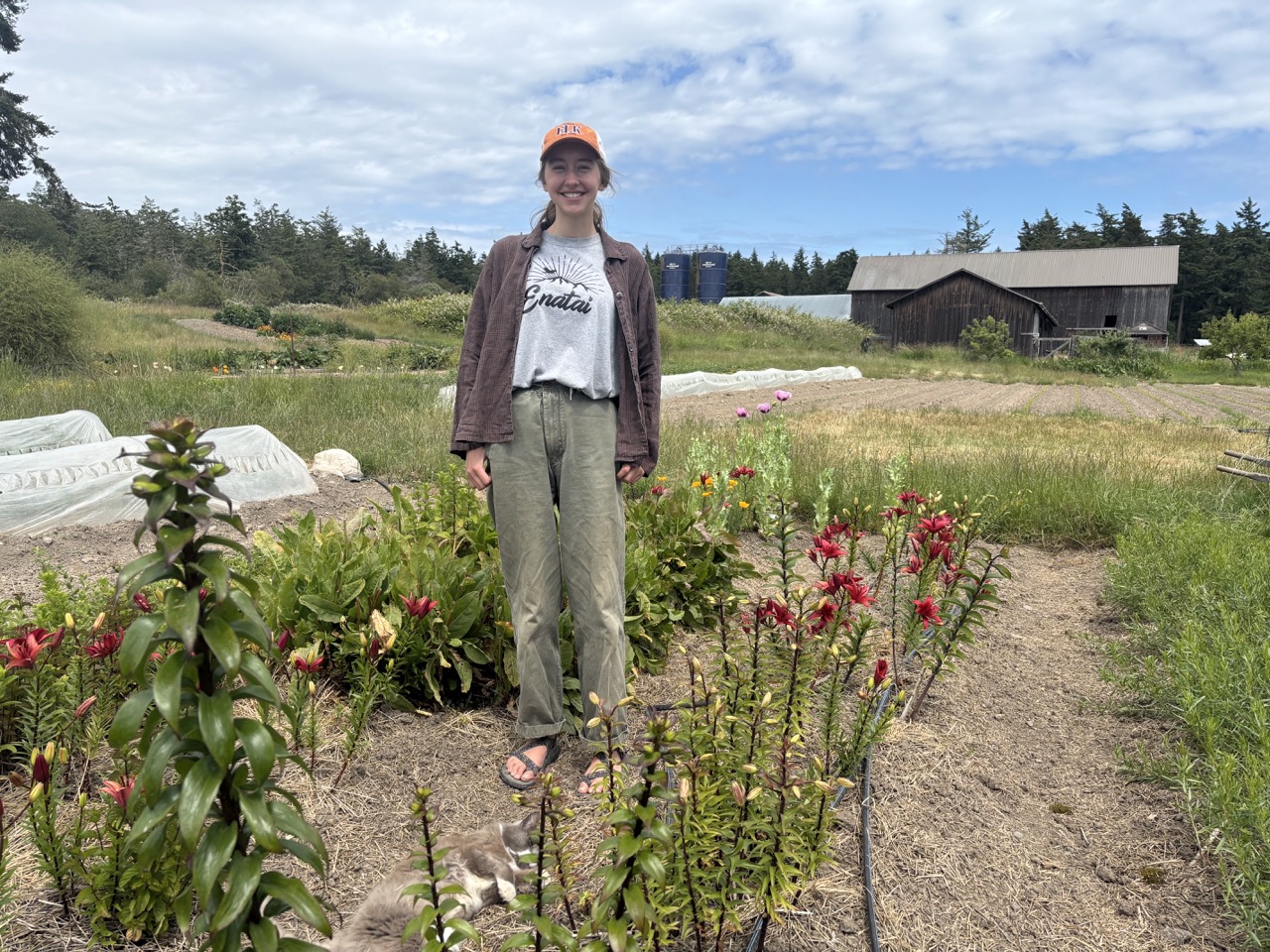
Maia Mouser at Horsedrawn Farm.
Maia arrived on Lopez in early June and is interning with LCLT at Horsedrawn Farm! She is interested in learning how natural ecosystems can be supported through agriculture and how to grow food. Maia is a student at Whitman College and has volunteered at Eloheh Farm in Oregon before.
News from 108 Grayling Lane
A slow and thoughtful approach to changes on the land
By Sage Dilts & Nathan Hodges
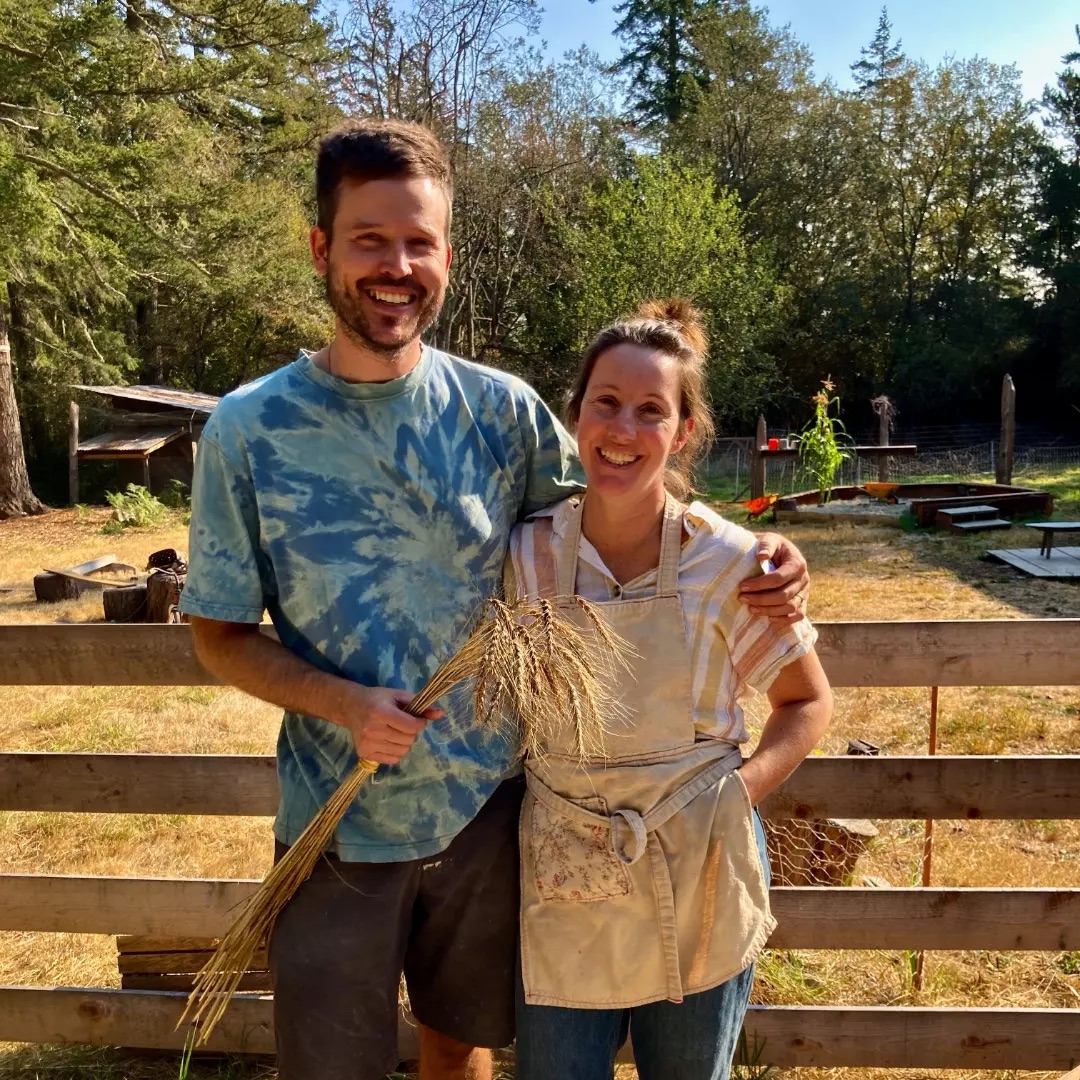
The land here at Grayling is in full abundance – it seems like it’s a good year for fruit as we’re seeing the first apples and plums from the trees we planted a few years back. The original Asian pear is loaded, we have our first hazelnuts coming on, and the fragrant sprays of the blue elderberry are transforming flower to fruit. From the woods we’ve been harvesting nettles, salmonberries, roses, wild strawberries, sweet cicely, fir tips, and the tender leaves from salal, Oregon grape, and twining blackberry for salads, teas, and tinctures. We’ve begun to integrate a small flock of sheep into our silvopasture system and appreciate the fertility and energy they bring to the property.
This is our fifth spring here on the land and while our to-do list remains long we are deeply appreciating the sense of a shift as our earlier clearing and plantings begin to mature into more stable and productive zones. We also value a slow and steady approach to making changes to the land – it’s easy to overlay our ideas onto the landscape only to find that in being too hasty or unobservant we miss an opportunity for cooperation with the inherent energy of the place – where water goes, where the soil is deepest, the little pockets of warmth on a frosty morning. Change in the landscape usually involves some sort of disturbance – clearing brush, cutting trees, tilling soil – to create opportunities for new guilds of plants and animals, new niches within the ecosystem. But of course, when we disturb the land there’s the potential to lose something as well – habitat, wildness, secret places, untidiness, the nooks and crannies that are so often smoothed in our human dominated landscapes. We try to be attentive to that tension – between disturbance as a path to greater ecosystem resiliency and the value of just leaving things alone. Or, as we like to say – what about the snails?
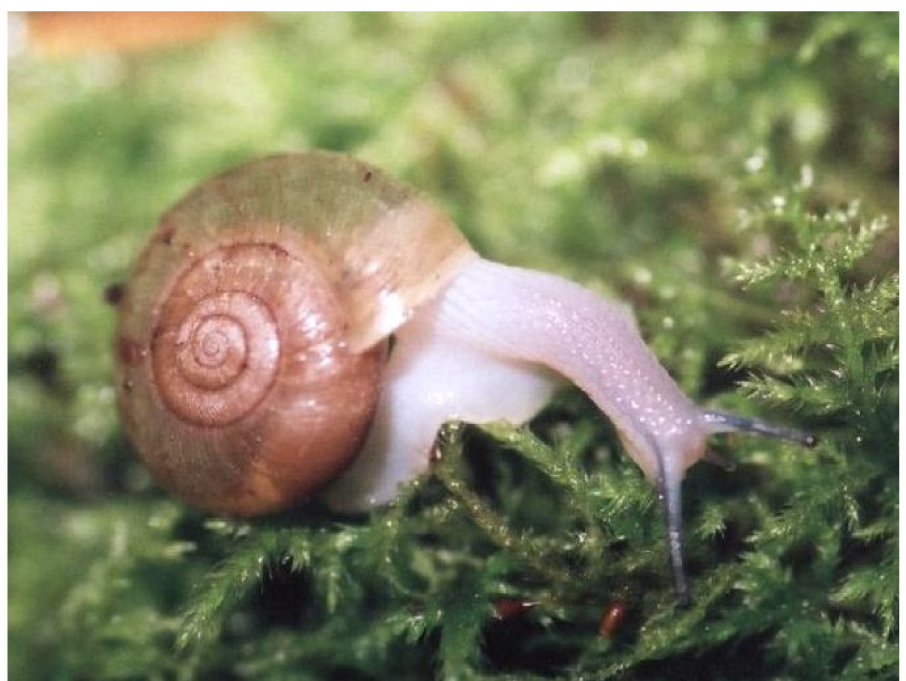
Haplotrema, a carnivorous land snail.
We’ve been big fans of terrestrial mollusks (slugs and snails) for a long, long time, having done mollusk focused environmental education and field research some decades ago. So we’re attentive to the slow, thoughtful, surprisingly complex lives of the gastropods or “stomach footed” ones that inhabit the forests and hedges of Grayling. The ubiquitous banana slug, Ariolimax columbianus, of course – the phenotype we see in our forest all have a black dot on their head and grow to be quite large – there’s a six-inch leviathan that lives underneath the back porch.
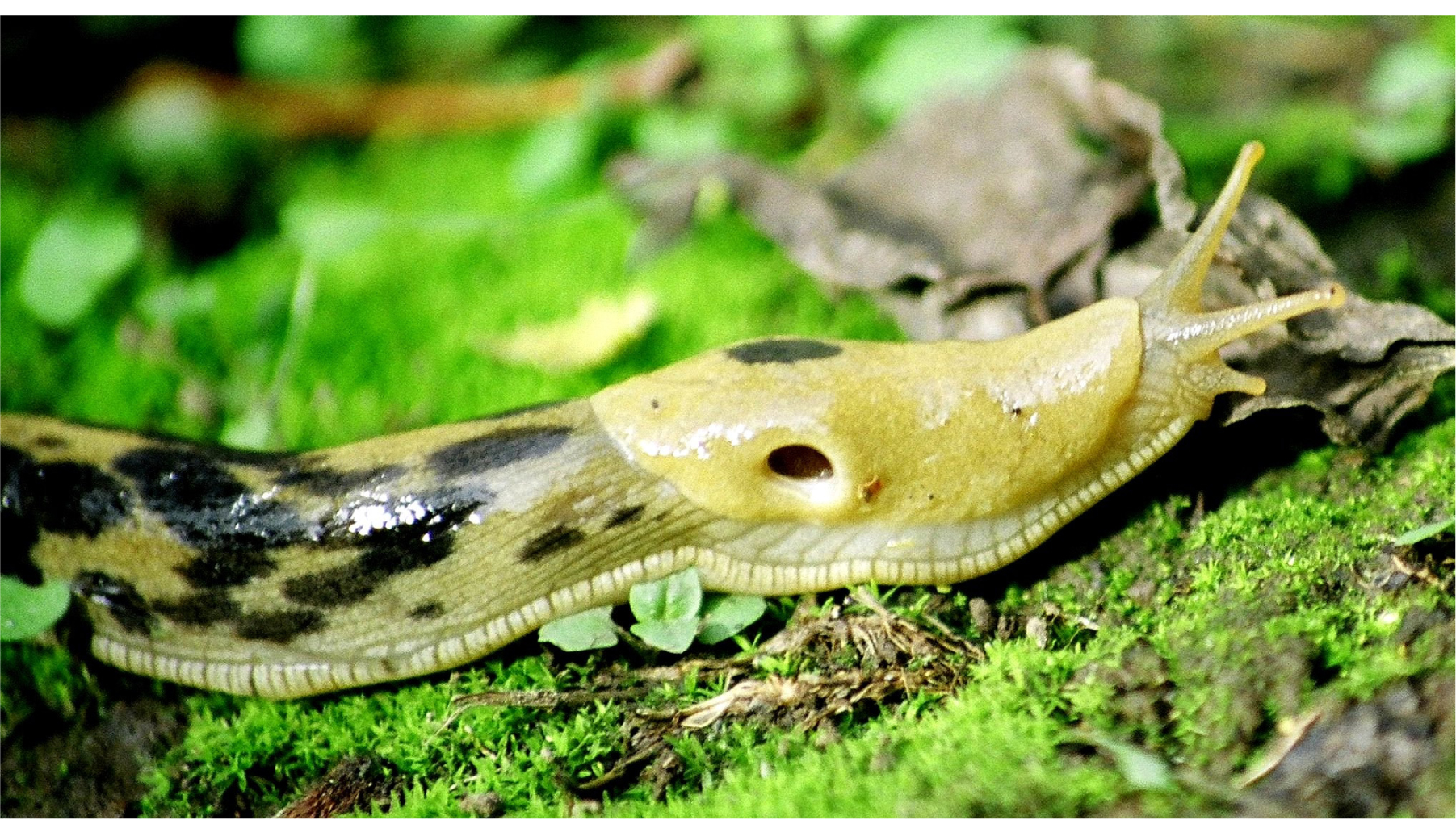 Ariolimax columbianus, banana slug.
Ariolimax columbianus, banana slug.
Then there’s the old man of the forest Monadenia fidelis – the Pacific Sideband – both the largest and longest lived of our terrestrial mollusk species here in the PNW – official estimates for its lifespan are over a decade. They are always a thrill to encounter on the mossy trunks of the oceanspray with their beautiful striped shell and pebbly pink skin. Then there’s the Haplotrema and Ancotremas – mid-sized yellow to green snails with soft translucent bodies – known to be carnivores, they are rather retiring and are rarely seen anywhere but under logs and thick moss. Vespericola columbianus – the Northwest Hesperian – has the most adorable tiny hairs on its small brown rather chubby shell. In the garden we of course see the Arion slugs – introduced garden lovers that will happily eat through the stems of our cucumbers in a night – we pluck them off and throw them to the chickens. Limax maximus – the spotted leopard slug is often on the bakery patio in the early mornings. We have a small population of Cepaea nemoralis along the driveway – technically an introduced European invasive, our cold climate doesn’t seem to encourage them to spread, and we love seeing their brightly colored and striped shells.
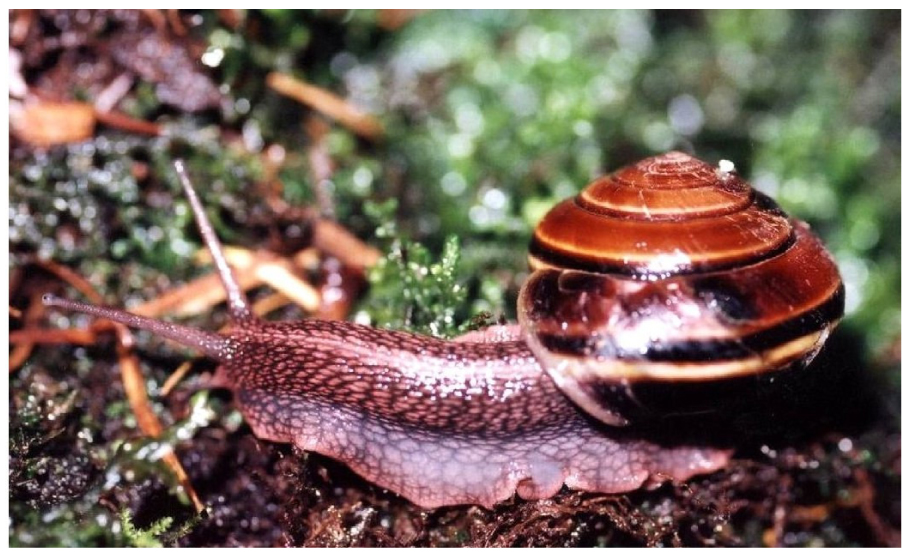
Monadeniafidelis – the Pacific Sideband.
As we work here at Grayling we try and notice and respond to our slow, sensitive mollusk neighbors, understanding that their home is this land, and we, as the primary agents of change (maybe excepting that Cascadia super volcano) in their ecosystem, are in some not-small way responsible for their continued slimy slow existence here. So we also move slow, ponder our next moves, chew meditatively on a leaf, and watch the beads of dew evaporate from the fruiting bodies of the moss in the deep woods on a misty morning.
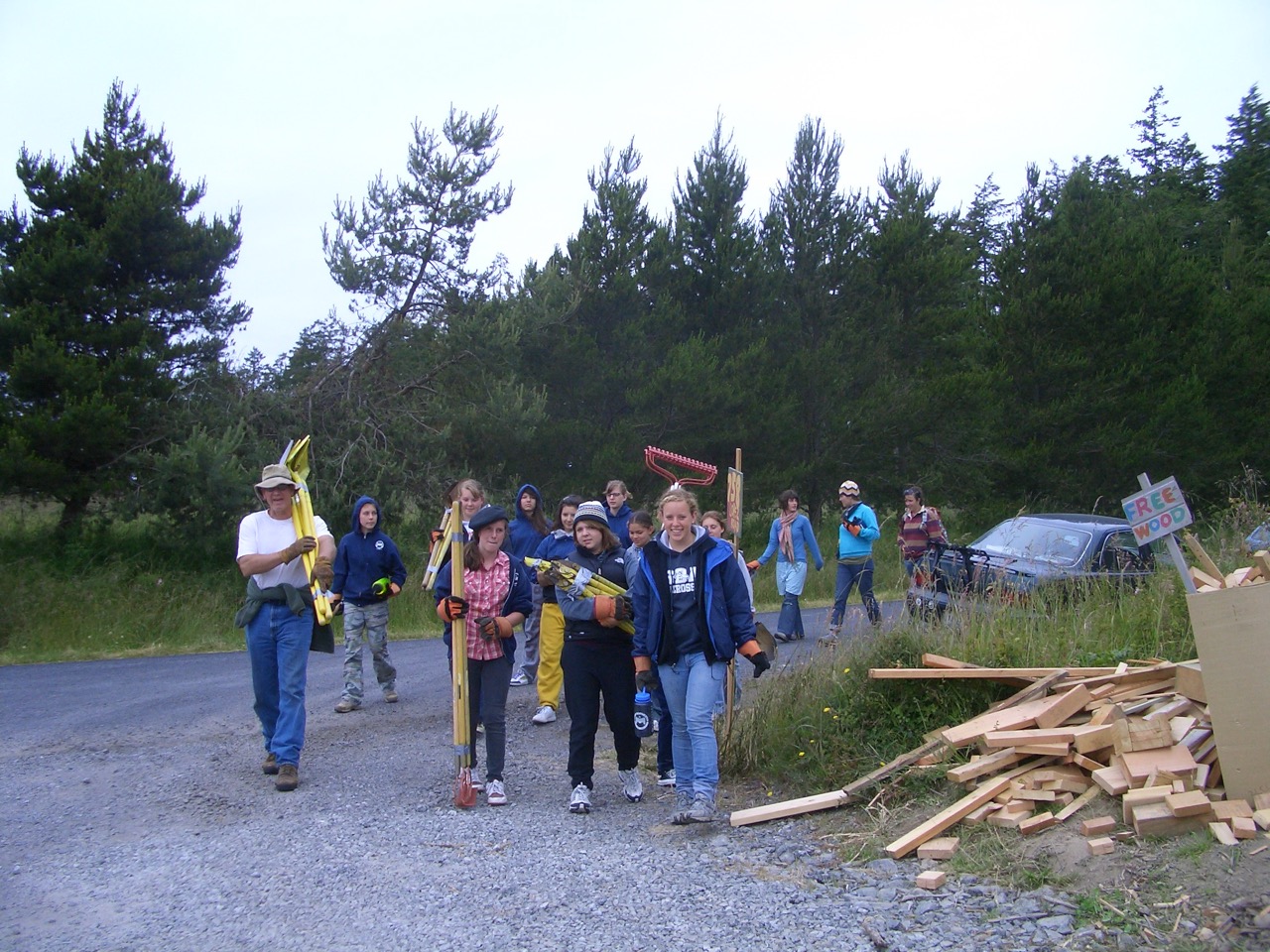
Paul Henriksen (at left holding yellow shovels) with volunteer campers from
Camp Nor’wester in 2008, helping at Common Ground.
Paul & Christa –
2024 Spirit Award Recipients
On Saturday June 14, just after the No Kings event, over 100 people gathered to celebrate Paul Henriksen and Christa Campbell who received the 2024 Spirit Award granted by the Lopez Community Center. Together Paul and Christa have volunteered at over a dozen non-profits, and both have run for and won in local elected positions. They are a dynamic duo who continue to serve the greater good of Lopez Island. This past year, Paul has dedicated almost every Tuesday to helping build homes with LCLT on Crayfish Way. Paul is also responsible for starting the Camp Nor’wester volunteer program and just about every year since 2008, LCLT has benefitted. LCLT has been the recipient of such good fortune – Paul being a big piece of that.
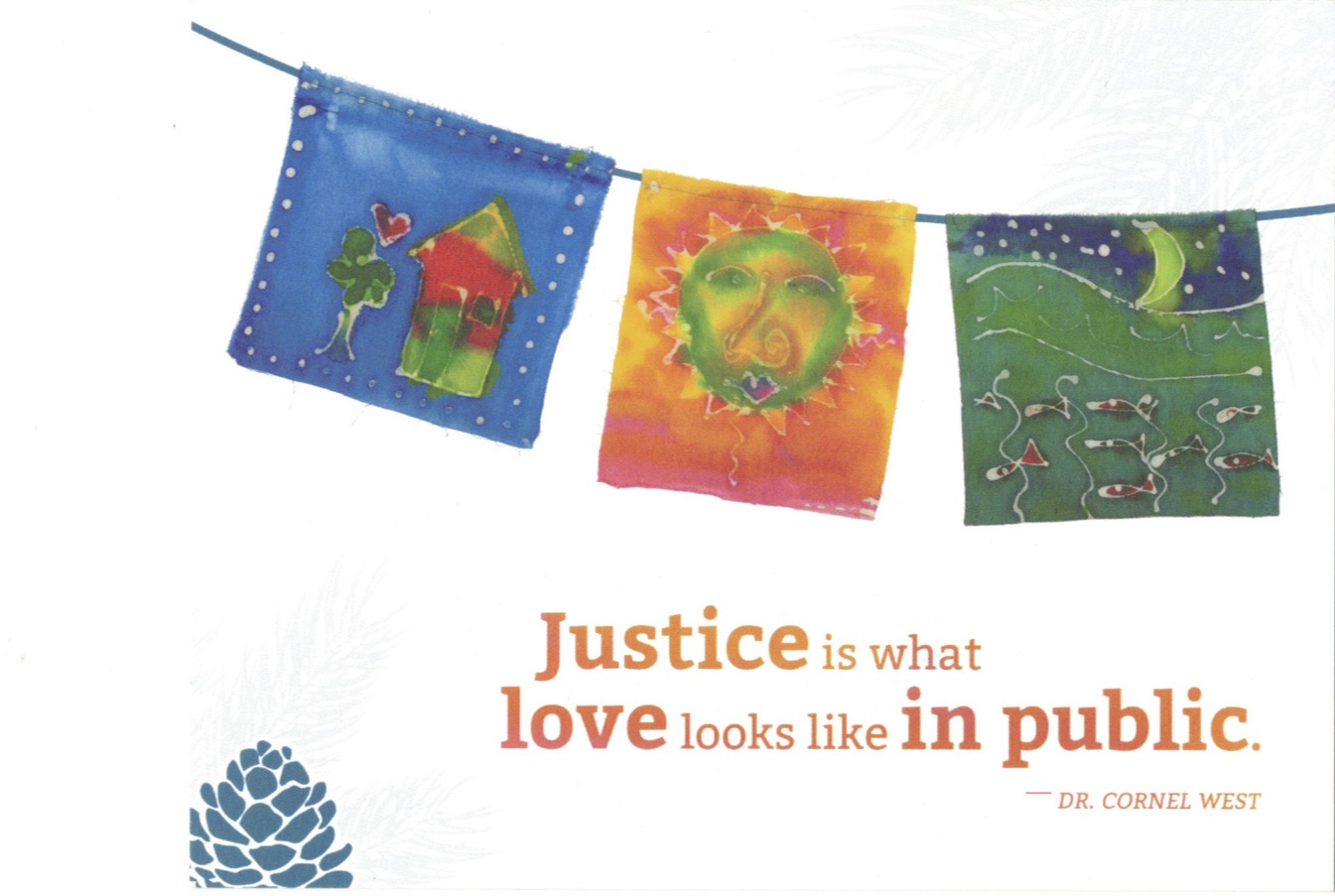
A card from our friends at Ecothrive Housing Trust in King Country who visited in March. Each batiked Unity Flag commemorates one of the 6,320 unsheltered people counted on the streets of King County during the 2018 “Count Us In” event. Unity Flags are a project of Love Wins Love.
Common Ground to Berkeley —
An EV Road Trip in the LCLT Carshare
By LCLT residents Chris & Chom Greacen
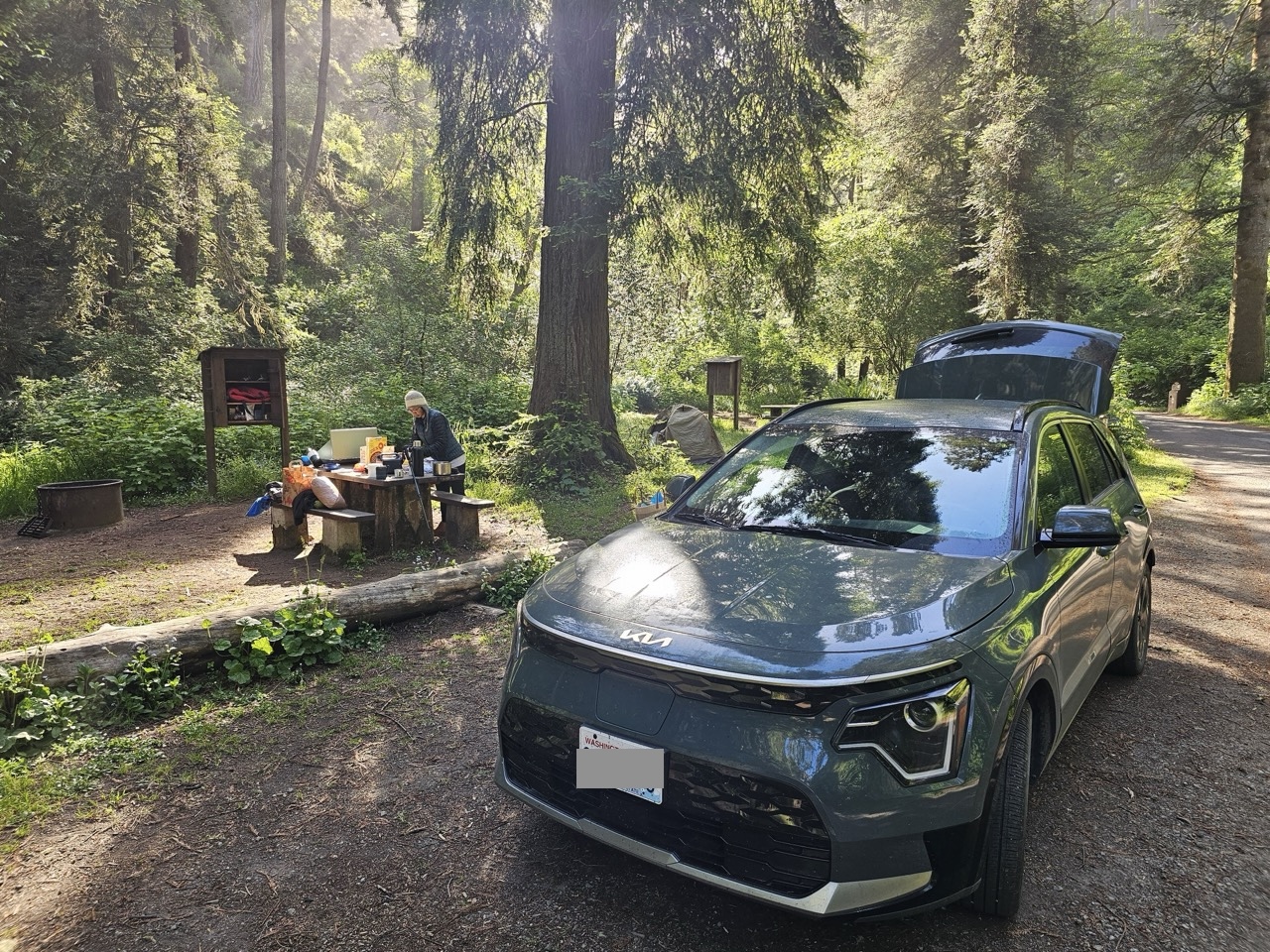
Car camping at Van Damme State Park in California.
(Bonus: free overnight EV charging here.)
 The LCLT carshare EV isn’t just for local trips. We (Chom and Chris) took the EV on its longest road trip to date, just under 2,000 miles, from Lopez Island down to Berkeley (primarily on I-5) and then back along the coast (Highway 1). In Berkeley we attended the 50th anniversary of the Energy and Resources Group (ERG) graduate program – the place where we met nearly 30 years ago – and caught up with many dear friends.
The LCLT carshare EV isn’t just for local trips. We (Chom and Chris) took the EV on its longest road trip to date, just under 2,000 miles, from Lopez Island down to Berkeley (primarily on I-5) and then back along the coast (Highway 1). In Berkeley we attended the 50th anniversary of the Energy and Resources Group (ERG) graduate program – the place where we met nearly 30 years ago – and caught up with many dear friends.
On the way back up the coast we were joined by our son Ty, who was on a short break between spring and summer semesters at college. We drove up the scenic route, Highway 1, taking six days mostly car camping and walking many hours each day on beaches or among the redwoods and visiting friends & family. The LCLT’s eNiro is a pleasure to drive! It proved to be super-efficient on the slower curvy and hilly coastal scenic route northbound. In particular, the regenerative braking feature extended the mileage we could travel between charges by charging up the battery during moderate braking down hills. The adaptive cruise-control is especially nice for highway driving. We set a desired speed, but if the car ahead slows down, we automatically slow down too. The Niro maintains a safe following distance, adjusting speed as necessary.
We had zero problems charging and never had to wait in line for a charger. The free Plugshare app (www.plugshare.com/) helped in three ways: first, in trip planning to give us confidence that there were necessary chargers along our route; second, as we were driving, to identify in real time chargers that were available and see user reviews; and finally, to identify free chargers. The free chargers were generally (but not always!) slower speed (“level 2”) chargers that we could sometimes take advantage of at rest stops, campgrounds or hotels to give a bit of a boost or fully charge overnight. Most of our charging was done at DC faster chargers. The Kia is limited in theory to 85kW charging speed, even if the charger has higher capacity (some do 150 kW or even 350 kW). In our experience, charging often maxed out at 50 kW or so. At this rate, we would get a “pretty full” charge in around an hour. We generally timed these to coincide with lunch, shopping or a walk.
(pictured left Our southbound journey on I-5 is shown in blue, and the northbound in red. Green charge icons indicate locations we slow-charged, while orange are fast chargers.)
By the numbers:
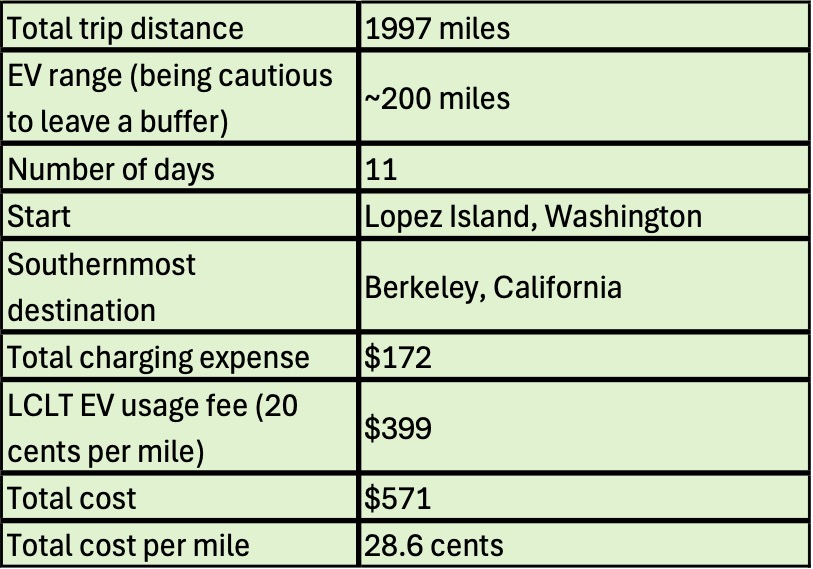

Electric vehicle charging station.
There are different charging networks and each requires its own app. For this trip we used Electrify America, ChargePoint, and Shell apps. For each, we needed to put in our credit card information. Once that info is in, charging is generally pretty seamless. We tapped our phone to the charger and plug in. If we went off on a walk, the app does an adequate job of keeping you apprised of how full the battery is getting. We paid a total of $172 for all of the charging we did. For reference, a car that gets 40 miles per gallon would have cost about $200 in fuel at $4 per gallon.
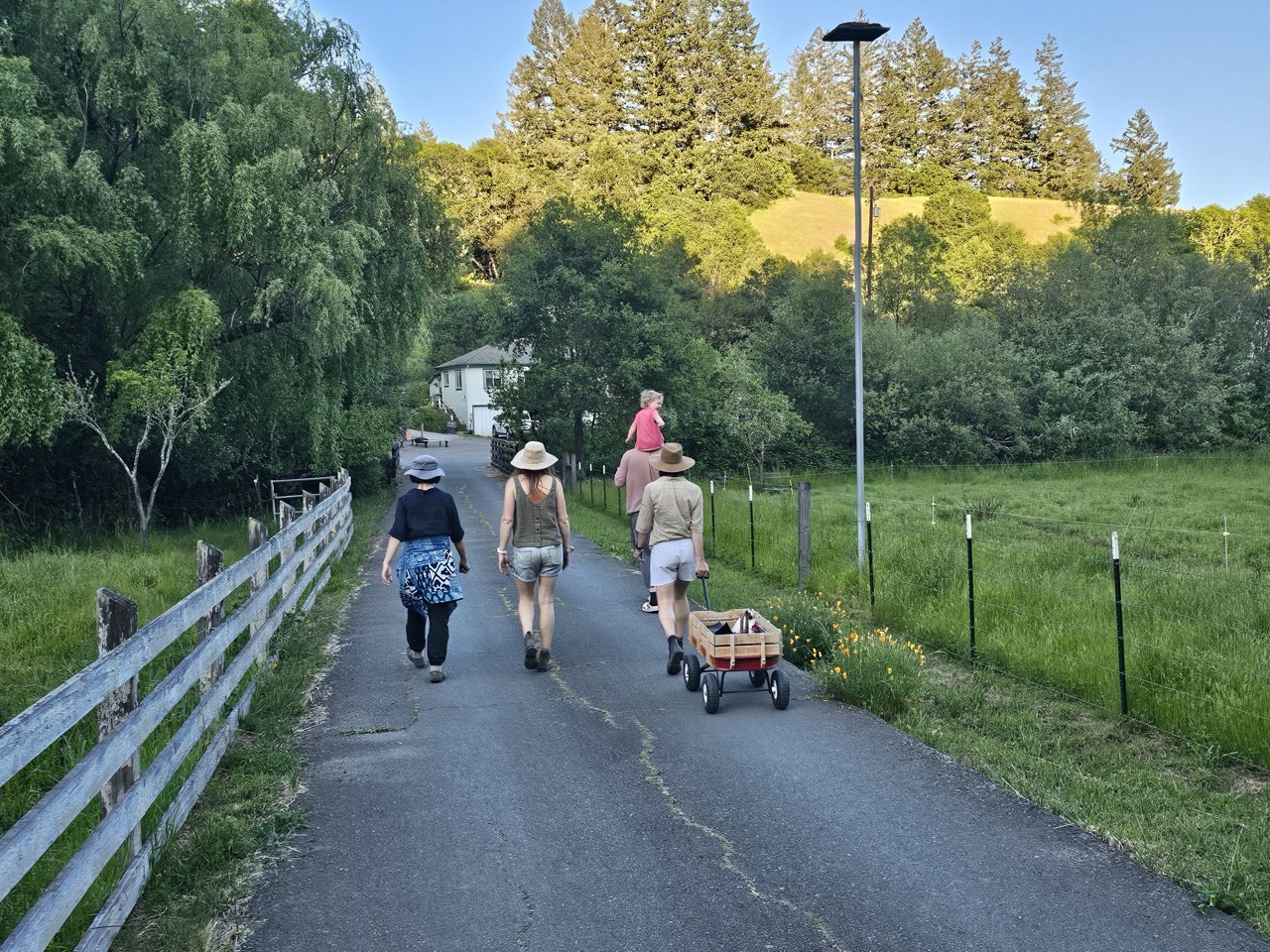
Visiting former LCLT Intern and fellow ERG alum Laney Signer
and her family at Green Valley Farm in Sebastopol, CA.
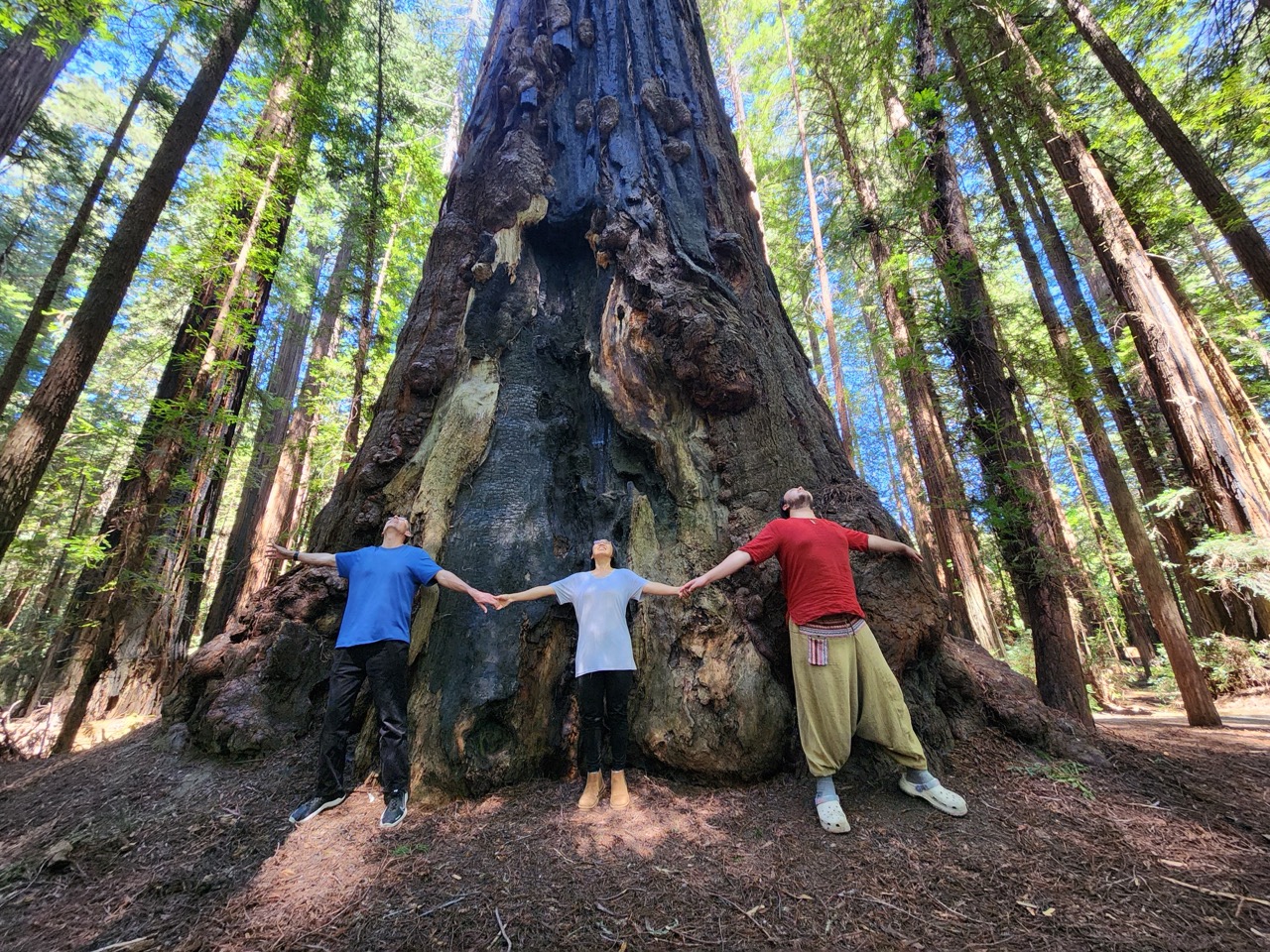
Big Redwood tree bearing scars of passing time and fire events.
The LCLT Carshare is open to all LCLT residents — learn more about the program on our website.
You’re Invited!
JazzGarden at Vita’s Wildly Delicious
A Benefit for Lopez Community Land Trust
Friday, August 8th
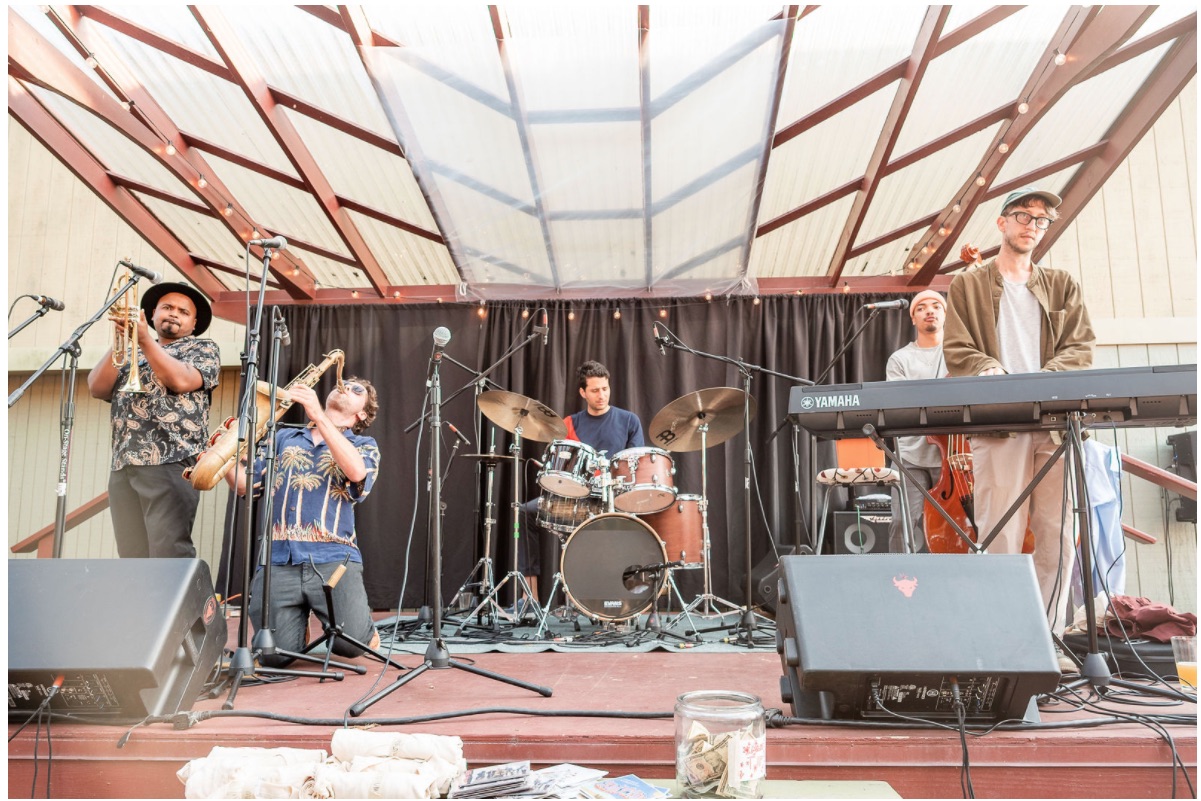
Photo by Andrea Huss Photography
Featuring music by Sammy Miller & the Congregation!
Join us for a night of joyful jazz to benefit LCLT programs in affordable housing, and sustainable agriculture.
Friday, August 8th, at 5:30pm at Vita’s Wildly Delicious
Juilliard trained Grammy® nominated drummer Sammy Miller has been hailed as “the perfect player scholar” (The Wall Street Journal).
Board of Directors
Joe Schneider, Chair
Luis Cisneros, Vice Chair
Grant Carlton, Secretary
Eleanor Brekke, Treasurer
Carl Petterson, Eli Derzay, Hannah Rose, Jan Marshall, Jonathan Cargill, Mark Eames, Quaniqua Williams
Staff
Sandy Bishop, Executive Director
Breton Carter, Assistant Director
Marly Schmidtke, Administrative & Project Director
Rhea Miller, Community Liaison
Lopez Community Land Trust · PO Box 25 · Lopez Island, WA 98261-8768 · USA
501(c)3 91-1469975



